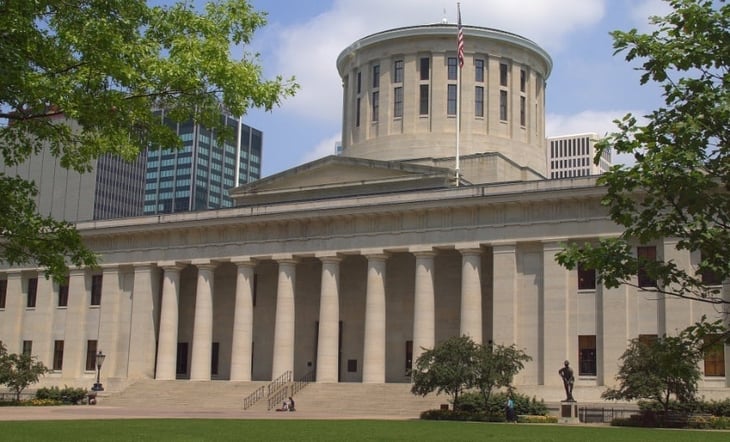 Even as Ohioans get ready to elect a new governor, the Ohio legislature is once again struggling to determine whether it will move forward, or backward, on energy policy. More than a year has passed since the Ohio House voted to approve House Bill 114, a bill that would effectively eliminate the state’s renewable energy and energy efficiency standards. Since then, Senate Leaders have worked to develop a compromise that preserves the state’s requirements but reduces them enough to satisfy the House without running afoul of Gov. Kasich, who vetoed lawmakers’ last attempt to gut the state’s RPS and EERS outright. The bill also needs to address the state’s burdensome wind setback requirement, which the Senate tried to fix in the 2017 budget bill. With time running out before the legislature breaks for summer recess, many are wondering – do Ohio lawmakers have the will to reach a constructive deal that finally puts Ohio’s energy policy on a stable course this year? Or will Ohio’s energy future be left to the legislature’s next session – and next governor?
Even as Ohioans get ready to elect a new governor, the Ohio legislature is once again struggling to determine whether it will move forward, or backward, on energy policy. More than a year has passed since the Ohio House voted to approve House Bill 114, a bill that would effectively eliminate the state’s renewable energy and energy efficiency standards. Since then, Senate Leaders have worked to develop a compromise that preserves the state’s requirements but reduces them enough to satisfy the House without running afoul of Gov. Kasich, who vetoed lawmakers’ last attempt to gut the state’s RPS and EERS outright. The bill also needs to address the state’s burdensome wind setback requirement, which the Senate tried to fix in the 2017 budget bill. With time running out before the legislature breaks for summer recess, many are wondering – do Ohio lawmakers have the will to reach a constructive deal that finally puts Ohio’s energy policy on a stable course this year? Or will Ohio’s energy future be left to the legislature’s next session – and next governor?
Unlike the House, Senators hoped their revision could “begin a constructive conversation” to Ohio’s energy policy. Originally, HB 114 proposed lifting the compliance mechanisms for the RPS and EERS, rendering the annual benchmarks voluntary before ending the programs in 2026, lowering the EERS, and expanding a provision that allows all customers – residential, commercial, and industrial – to choose not to participate in utility-funded efficiency programs. Though the version now under consideration by the Senate maintains the annual RPS and EERS benchmarks and a revised the wind setback that could unleash $4 billion in economic activity, it also reduces the RPS and EERS and expands the existing efficiency opt-out for the state’s largest energy users.
While correcting the wind setback, the Senate draft falls short as comprehensive energy policy. It hardly scratches the surface for renewable energy potential and leaves millions in consumer savings on the table by making energy efficiency investments optional for the state’s largest energy users. By failing to recognize the economic benefits of renewable energy and energy efficiency, Ohio lawmakers are subjecting consumers and businesses to higher energy costs rather than putting money back into their pockets.
With a limited number of days on the legislative calendar, the pathway to completion is not clear. Just last month, former Speaker Cliff Rosenberger resigned abruptly when news of an FBI investigation into his travel expenses became public, leaving the House in disarray and without a Speaker for weeks. There is also the memory of Gov. Kasich’s veto of HB 554, a bill that took aim at killing the state’s standards in 2016. Following the House passage of HB 114 last year, Kasich reaffirmed his support for Ohio’s energy rules. “Now, it doesn't make a lot of sense for the legislature to take us back…on the issue of renewables,” Kasich declared at an event at AEE member Amazon, a major purchaser of renewable energy.
Assuming the Senate approves a version of its bill, several scenarios could play out: 1) House concurs with the changes, sending HB 114 to the Governor, 2) House leaders decide to not take up HB 114 before summer recess, opting for a showdown during lame-duck session at the end of the year, 3) House and Senate leaders conference on HB 114 to negotiate a final package behind closed doors, or 4) energy policy gets kicked into 2019 for the new governor and legislature to address.
One thing is clear: Ohio’s energy policy will continue to be a hot issue leading up to the 2018 gubernatorial elections. Republican Attorney General Mike DeWine and Democrat and former state A.G. and federal Consumer Financial Protection Bureau head Richard Cordray are set to square off in November. One of these men will have an opportunity to leverage energy policy as an economic development tool, securing their legacy as a job-creating governor for the state of Ohio.
Ohio AEE met with both candidates prior to the primary to acquaint them with the economic benefits of advanced energy. We also delivered to them, and released publicly, “Ohio’s Advanced Energy Roadmap – How the next governor can capture the economic benefits of Ohio’s energy portfolio – and drive job creation and economic growth.” This policy platform highlights the need for policy that stabilizes Ohio’s energy market, lifts barriers that prevent investment in innovative technologies, and protects consumers from energy price volatility.
Following six years of continued policy uncertainty, lawmakers have two choices – take advantage of forward-looking energy policies that protect consumers and rebuild Ohio’s competitive advantage this year, or kick the can down the road again. If they do the latter, it will be with a new governor who, like the incumbent, knows all about the economic benefits of advanced energy.
